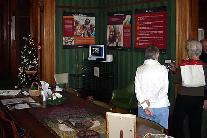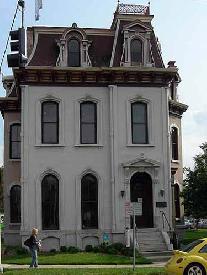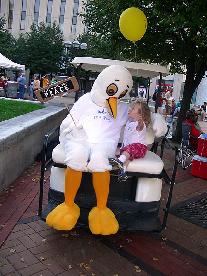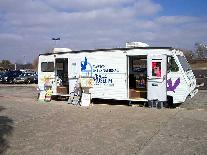AMERICAS
Dayton International Peace Museum (USA)
(May 12, 2009)
by Kate Johnson, Education Specialist
On a warm summer afternoon in 2003, Christine Dull was struck by a sudden inspiration. Dull, a long-time peace activist and citizen-diplomat from Dayton, Ohio, was traveling home from an observation tour of war-torn Iraq with her husband, Ralph, when it came to her: Dayton, a city with a reputation for innovation, was known internationally for its host role in the 1995 Bosnian Peace Accord talks, yet locally it was better known as the home of the popular U.S. Airforce Museum. Why shouldn’t Dayton also boast a museum dedicated to transforming our culture of violence into a culture of peace?
The Dayton Peace Museum would be a non-partisan cultural and educational facility chartered to promote the concept of peace and the viability of nonviolent solutions to conflict at the local, national, and international levels. It would particularly seek to address educational gaps, with regard to peace and peacemaking, of children, recognizing that they will become the world’s future peacemakers.
Excited by the concept, Chris and Ralph recruited friends and activist colleagues Fred Arment and Lisa Wolters, both experienced marketing professionals, to help develop it. Over the next year, the four worked long hours, developing a business plan, obtaining the necessary non-profit documents and designing the Museum’s first main exhibit, showcasing Nobel Peace Laureates. They obtained a $10,000 grant from the Dayton People’s Fund, supplementing this seed money out of their own pockets.
On October 14th, 2005, the Dayton International Peace Museum opened its permanent doors in an historic 19th-century three-story mansion, the Pollack House, at 208 W. Monument Avenue in downtown Dayton. By then, the Museum had attracted more than 100 volunteers, who gladly donated their time, labor, ideas, and personal funds to the creation of this unique “Space to Make Peace.” U.S. veteran and retired police officer Steve Fryburg loved the idea so much he came on board as the Museum’s full-time, pro-bono director.
Only three and a half years later, the Dayton International Peace Museum has already made great strides toward establishing itself as an important cultural and educational institution for peace. Through a variety of cultural events, educational programs, and partnership initiatives, the Museum has endeavored to bring the “ways to peace” into the public consciousness. Just a sampling of achievements to date includes:
*Mounting nearly two dozen quality exhibits on nonviolence and social justice issues. Some examples:
“Bosnia Revisited: Photos Without Borders” Seattle photographer Steve Horn’s exhibition of photographs of Bosnia taken 33 years ago and recently. Showing how the war changed the people and country.
“Children of War” exhibition contained powerful and haunting images of children taken by U.S. soldiers during the Viet Nam conflict.
“Nonviolent Solutions” gives the visitor a view seldom seen about the history of nonviolence in the world and its successes. The exhibit provides real world nonviolent solutions to today’s problems.
“Art for Peace” is an annual art exhibition that challenges artists to inspire people to peace.
“Darfur” Through powerful photos, videos, and information, visitors were made aware of the ongoing human right abuses in the Sudan and what we can do about them.
Permanent exhibits include:
“Little Boy / Fat Man” is an artist’s rendition of the bombings of Hiroshima and Nagasaki. Very compelling images bring the reality of the horrors delivered by nuclear weapons.
“Sister Dorothy Stang” exhibit documents the life and death of this nun of the Sisters of Notre Dame de Namur order, who was murdered in Anapu, a city in the state of Pará, in the Amazon Basin of Brazil. Sister Dorothy was outspoken in her efforts on behalf of the poor and the environment, and had previously received death threats from loggers and land owners. The exhibit includes her passport and a t-shirt worn by her.
“The Right to Peace” exhibit examines the historical basis for a human right to peace. Beginning with Cyrus the Great who declared the first Charter of Human Rights known to humankind in 539BCE, the exhibit cites a number of historical foundations for a human right to peace.
*Bringing nonviolent conflict management training into area schools with our Peace Abilities™ curriculum and Peer Mediation Continuum™
*Establishing annual local events to celebrate and publicize Peace, including Summer Peace Camp, Dayton Peace Accords 5K Run, Dayton Peace Festival, and Screen Peace™ Film Festival, all now in their third year
*Collaborating with other local organizations on projects like the Dayton: City of Peace campaign, High School Peacemaker awards and Mountain Top intercultural dialogue
*Building grass-roots international peace bridges through educational/cultural exchanges with organizations in Iran, Pakistan, India, Kenya, and other countries
The unpaid staff and volunteers have also worked hard to ensure that the Museum is taking deep root in the heart of the community it exists to serve, by fostering lasting community transformation through inter-racial, inter-cultural, inter-religious, and inter-personal understanding and harmony.
The Peace Museum’s mascot “Big Dove” is a hit with young and old at public events, such as the annual Peace One Day Celebration, and the museum goes mobile with the PeaceMobile, an old discarded recreational vehicle converted into a peace museum on wheels.
Dayton Mayor Rhine McLin, a member of the Hiroshima-based international organization, Mayors for Peace, proudly points to the Dayton International Peace Museum as an example of the best that Dayton has to offer.
Address: 208 W. Monument Ave.Dayton, OH 45402 USA
Phone: +1-937-227-3223
Homepage: http://www.daytonpeacemuseum.org
Days closed: Monday and Tuesday, major holidays
Admission: Free (donations are greatly appreciated)
(Originally published on May 4, 2009)
 Peace Museums of the AMERICAS
Peace Museums of the AMERICAS



